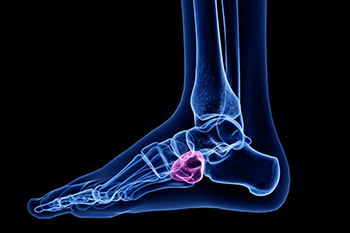
 Cuboid syndrome (also known as cuboid subluxation) involves a tear or injury to the joint and/or ligaments near the cuboid bone in the foot. The bones move but are not fully displaced when one has this condition. Ankle sprains or injuries are often the culprit of this syndrome, but it can also be caused by repetitive strain of the foot or having flat feet. As with many foot problems, this syndrome is more likely to affect those who are: overweight, have arthritis or bone conditions, wear improperly fitting shoes, do not stretch well before exercise, do not allow enough rest of the foot before resuming physical activity, exercise on uneven surfaces, or fracture a bone connected to the cuboid. One can suspect cuboid syndrome if there is pain on the side of the foot near the baby toe, which may intensify with weight bearing or pushing on the arch on the bottom of the foot. The pain can also spread to other parts of the foot when pressure is exerted on the front of the toes, there may be redness near the injured area, swelling of the injured area and ankle due to fluid buildup, less movement of the ankle or lateral side of the foot, weakness in toes on this side of the foot and an altered gait to compensate for pain. Treatments for cuboid syndrome vary and it is suggested that a podiatrist be consulted for proper diagnosis of the condition and pinpointing the best course of action for your case.
Cuboid syndrome (also known as cuboid subluxation) involves a tear or injury to the joint and/or ligaments near the cuboid bone in the foot. The bones move but are not fully displaced when one has this condition. Ankle sprains or injuries are often the culprit of this syndrome, but it can also be caused by repetitive strain of the foot or having flat feet. As with many foot problems, this syndrome is more likely to affect those who are: overweight, have arthritis or bone conditions, wear improperly fitting shoes, do not stretch well before exercise, do not allow enough rest of the foot before resuming physical activity, exercise on uneven surfaces, or fracture a bone connected to the cuboid. One can suspect cuboid syndrome if there is pain on the side of the foot near the baby toe, which may intensify with weight bearing or pushing on the arch on the bottom of the foot. The pain can also spread to other parts of the foot when pressure is exerted on the front of the toes, there may be redness near the injured area, swelling of the injured area and ankle due to fluid buildup, less movement of the ankle or lateral side of the foot, weakness in toes on this side of the foot and an altered gait to compensate for pain. Treatments for cuboid syndrome vary and it is suggested that a podiatrist be consulted for proper diagnosis of the condition and pinpointing the best course of action for your case.
Cuboid syndrome, also known as cuboid subluxation, occurs when the joints and ligaments near the cuboid bone in the foot become torn. If you have cuboid syndrome, consult with Dr. Harris L. Klear from Burlington County Podiatry Associates. Our doctor will assess your condition and provide you with quality foot and ankle treatment.
Cuboid syndrome is a common cause of lateral foot pain, which is pain on the outside of the foot. The condition may happen suddenly due to an ankle sprain, or it may develop slowly overtime from repetitive tension through the bone and surrounding structures.
Causes
The most common causes of cuboid syndrome include:
Symptoms
A common symptom of cuboid syndrome is pain along the outside of the foot which can be felt in the ankle and toes. This pain may create walking difficulties and may cause those with the condition to walk with a limp.
Diagnosis
Diagnosis of cuboid syndrome is often difficult, and it is often misdiagnosed. X-rays, MRIs and CT scans often fail to properly show the cuboid subluxation. Although there isn’t a specific test used to diagnose cuboid syndrome, your podiatrist will usually check if pain is felt while pressing firmly on the cuboid bone of your foot.
Treatment
Just as the range of causes varies widely, so do treatments. Some more common treatments are ice therapy, rest, exercise, taping, and orthotics.
If you have any questions, please feel free to contact one of our offices located in Marlton and Delran, NJ . We offer the newest diagnostic and treatment technologies for all your foot care needs.